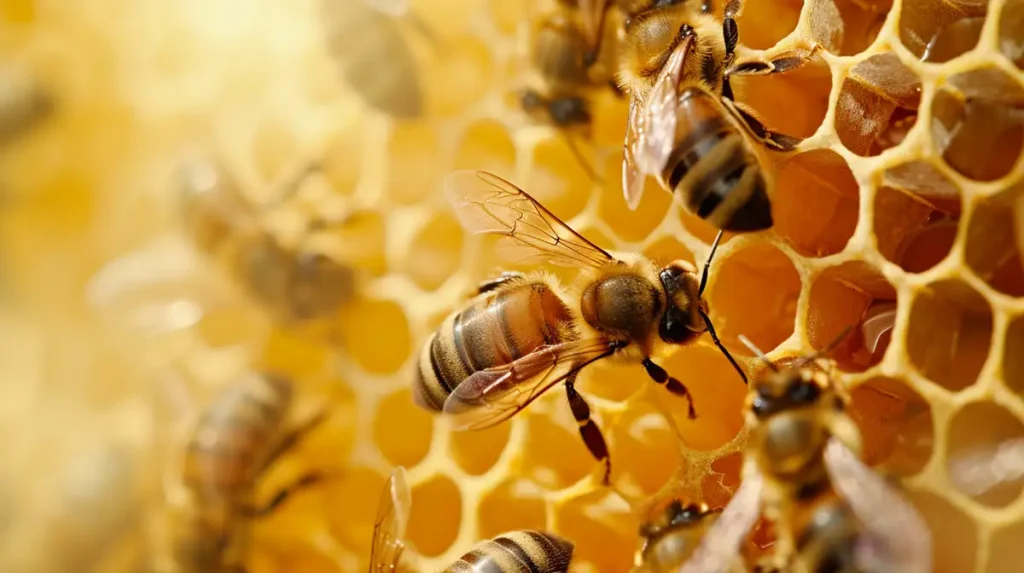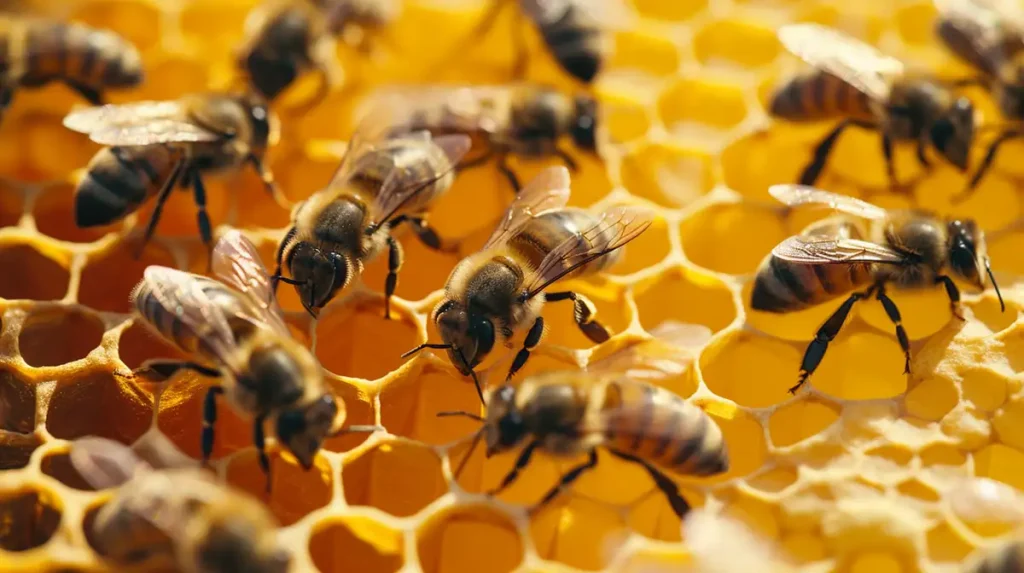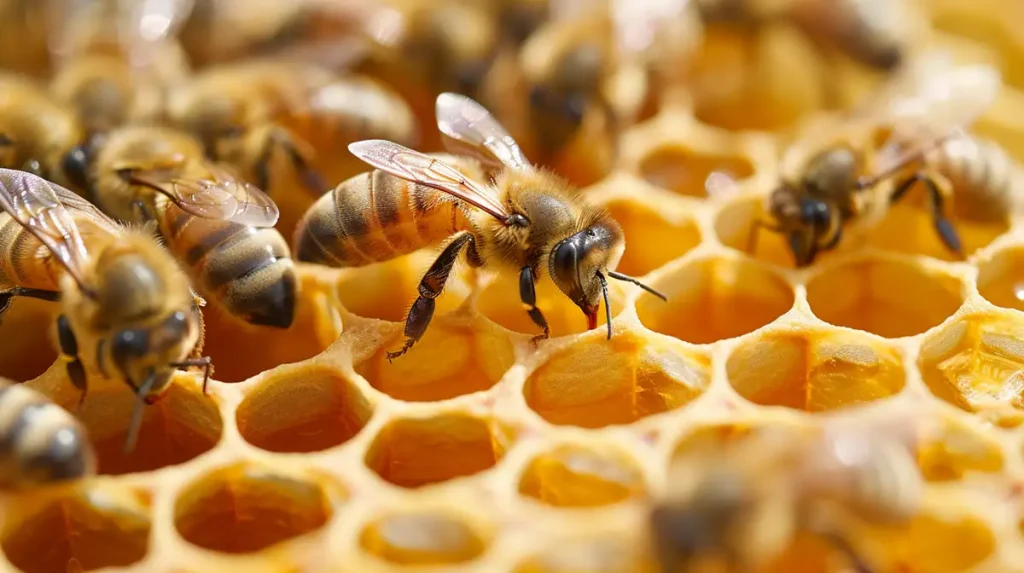Table of Contents
Beehives are ingeniously constructed by bees using beeswax, which they secrete from special glands in their abdomen. Worker bees skillfully mold this wax into hexagonal cells, creating a highly efficient, space-saving structure known as honeycomb. These combs are then used to store honey, pollen, and to house their larvae, forming the intricate and bustling environment of the beehive.
In the below paragraphs, we will take a more detailed look at this topic.
The classic image of a beehive (nest) hanging from a tree limb and oozing honey is a familiar one. But it is largely an image of Hollywood portrayal. In reality, bees rarely make hives that look so friendly and attractive. A genuine hive looks a lot more rugged and rough around the edges.
Different bee species have different habits for building their hives. Some species prefer to find hollowed out areas in old trees. Others are willing to make hives in the open spaces between rocks. Still other species bore into wood or build their hives in soil. Needless to say, there are lots of possibilities thanks to the endless potential nature offers.
What are Beehives Made Of?
A beehive is a marvel of nature and an incredible feat of engineering. It is a complex structure made up of a combination of two materials: wax and propolis. Both of these materials are produced by the bees themselves and are essential to the survival and functionality of the colony.
Bees Wax
Beeswax is a unique substance that is produced by bees in their wax glands. It is used to build the individual cells of the honeycomb, which serves as the nursery, food storage, and home of the colony. Beeswax is formed through a fascinating process. Bees have three stomach compartments, the first of which is called the crop. When bees collect nectar and pollen, it is stored in the crop. The enzymes in the crop react with the sugars in the nectar to produce wax, which is then excreted by the bee.
Once the full bee returns to the hive, it regurgitates the contents of its crop and another bee ingests it. This process is repeated until most of the water content is removed and the wax becomes malleable. At this point, bees chew on the wax to make it more pliable and then they use it to build the cells of the honeycomb. The hexagonal shape of the cells is the most efficient use of space and allows for the maximum amount of honey to be stored.
Propolis
Propolis is a sticky substance that is made by mixing beeswax with bee saliva and materials collected from foliage such as tree sap and plant buds. It has many functions in the hive including sealing gaps and cracks in the honeycomb, protecting the colony from disease, and strengthening the hive’s structure. Propolis has antiseptic and antibacterial properties, which help to keep the hive clean and healthy.
In addition to its protective functions, propolis is also used by bees to regulate the temperature inside the hive. Bees are able to control the temperature inside the hive by fanning their wings to circulate air or by clustering together to conserve heat. Propolis helps to insulate the hive, which is essential for keeping the colony warm in colder temperatures.

How Do Bees Make Hives in Trees?
Bees have been known to build their homes in various locations, one of which is in trees. Tree cavities, cracks, and hollows make great homes for bees as these offer protection from harsh weather conditions, predators, and other disturbances. The process of how bees make hives in trees involves several steps: finding a suitable location, producing wax and propolis, and constructing the nest.
Different species of bees have different preferences when it comes to nesting in trees. Honeybees, for example, are known to look for deep openings that provide full access to the inside of the tree. Bumblebees, on the other hand, prefer to build their nests closer to the surface. The type of location chosen by the bees is crucial as it affects the ease of construction and the overall success of the hive.
Once the bees have found a suitable location, they begin producing the beeswax and propolis they need to construct the hive (as described above). Worker bees inside the tree then start constructing the nest. This process involves building one chamber at a time, with each chamber being used for a specific purpose. The first chamber is usually the nursery, where the queen lays her eggs. The next chambers are used for storing pollen and honey as well as providing space for the bees to live.
- Carter, Anthony (Author)
- English (Publication Language)
- 194 Pages - 02/28/2024 (Publication Date) - Independently published (Publisher)
While the worker bees are busy constructing the nest, foraging bees continue to bring back raw materials with every pollen run. This includes pollen, nectar, and additional wax and propolis as needed. As the hive grows bigger, more bees are needed to maintain it. The queen continues to lay eggs and the colony expands to accommodate the increasing number of bees.
How Long Does it Take Bees to Make a Hive?
The first step in building a hive is for a group of bees to break off from an existing hive to establish a new colony. This process is known as swarming and typically occurs in the spring or early summer when the colony has reached its maximum capacity. The swarm will include the queen bee and a large number of worker bees who will set out to find a suitable location for their new home.
Once a suitable location has been found, the bees will begin the process of building their hive. This process begins with the construction of the comb, which is made from beeswax and serves as the foundation of the hive. The comb is constructed by the worker bees who produce wax from glands on their abdomen. The wax is then molded into the characteristic hexagonal shape of the honeycomb.
As the comb is constructed, the queen bee will begin to lay eggs in the cells of the comb. These eggs will hatch into larvae and eventually emerge as adult bees. The worker bees will also begin to store food in the comb, including honey and pollen, which will be used to feed the colony throughout the year.
Assuming normal conditions, a new colony of bees can have a functional hive up and running in about a month. However, the process of building and expanding the hive is ongoing and never truly ends. As the colony grows and more bees are added to the hive, they will continue to build and expand the comb to accommodate the growing population.
Why Do Bees Make Hives in Houses?
When bees are searching for a new location for their hive, they consider several factors. The primary consideration is the availability of nearby food sources. Bees need nectar and pollen to survive, and they will typically build their hives close to fields, gardens, and other flowering plants. They also require a nearby water source to stay hydrated and maintain their hive’s internal temperature.
Bees are also highly vulnerable to predators such as birds, mice, and other insects. To protect their hive, bees look for secure locations that offer protection from these threats. This is where human houses come into play. If bees can gain access to a building’s interior, they have a safe and secure location to build their hive. The walls of a house provide insulation and protection from the elements, which is especially important during harsh weather conditions.
When bees discover a suitable location, they use their highly sophisticated communication system to alert the rest of the colony. Through a series of complex dances and pheromones, worker bees communicate the location and quality of the new site. Once the colony decides on the location, they begin to build their hive.
The convenience of a human house as a hive location cannot be overstated. The structure of a house provides a foundation for the bees to build their hive, which means they don’t have to expend as much energy building their comb from scratch. Additionally, the structure of a house provides support and stability for the comb, which is essential for the colony’s survival.
However, while bees’ choice to build hives in human houses may seem convenient for them, it can be problematic for humans. If left unchecked, a bee colony in a house can cause significant structural damage and create a potentially dangerous situation for those living in the home. As such, it’s essential to contact a professional beekeeper or pest control service to safely and humanely remove the colony.

Why Do Bees Make Hives Underground?
The phenomenon of bees making hives underground is not uncommon. In fact, it is estimated that around 70% of bee species build their hives underground. This is quite surprising to most people as we often associate beehives with above-ground structures such as trees, buildings, or man-made beehives.
The obvious reason we do not see many underground beehives is because they are hidden from view. Bees that construct underground hives typically inhabit abandoned rodent burrows or other underground cavities. These natural underground spaces provide a safe and protected environment for bees to build their colonies. In some cases, bees may even dig their own burrows, creating a suitable home that meets their specific needs.
The decision to build an underground hive is motivated by similar factors that influence other species of bees to build above ground. Protection against predators and the weather is paramount in the minds of bees when selecting a nesting site. Underground beehives are often more difficult for predators to locate and infiltrate, providing a secure environment for the bees and their young. Additionally, underground spaces can provide a stable environment with a relatively constant temperature and humidity level, which is important for the health and wellbeing of the colony.
As well as offering protection and stability, underground spaces often provide bees with easy access to food and water sources. Bees require a constant supply of nectar and pollen to feed the colony and maintain their own health. Underground burrows that are located near a reliable food source can be particularly attractive to bees. Similarly, access to water is also essential for bees, and underground spaces near a water source can provide an ideal location for building a hive.
How Are Beehives Made – Conclusion
In conclusion, the image of a beehive hanging from a tree limb and dripping with honey is largely a Hollywood portrayal. In reality, bees build their hives in a variety of locations, including trees, houses, and underground burrows. The process of building a hive involves the production of wax and propolis, which are essential to the hive’s survival and functionality. Bees are remarkable creatures, and their ability to construct complex structures like the hive is a testament to their intelligence and adaptability. As beekeepers or concerned citizens, it is important that we understand the habits and preferences of bees to help protect and support their populations.
Last update on 2024-04-17 / Affiliate links / Images from Amazon Product Advertising API


